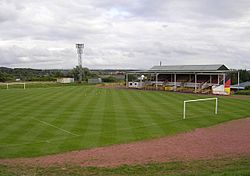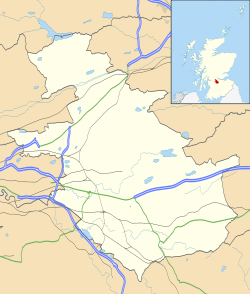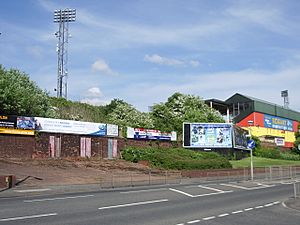Cliftonhill facts for kids
| Location | Coatbridge, Scotland |
|---|---|
| Coordinates | 55°51′37″N 4°00′41″W / 55.86028°N 4.01139°W |
| Owner | Albion Rovers F.C. |
| Capacity | 1572 (489 seated) |
| Field size | 110 yd × 72 yd (101 m × 66 m) |
| Surface | Grass |
| Opened | 1919 |
| Tenants | |
| Albion Rovers F.C. (1919 – Present) Coatbridge Monarchs (1968 – 1969) Coatbridge Tigers (1973 – 1977) Hamilton Academical F.C. (1997 – 1999) Dumbarton F.C. (2001) |
|
Cliftonhill Stadium, often called Cliftonhill, is a football stadium in Coatbridge, Scotland. It is the home ground for the football team Albion Rovers F.C.. The team has played here since 1919. For sponsorship reasons, it is currently known as 'The Reigart Stadium'.
Contents
A Look at Cliftonhill's History
Albion Rovers moved to Cliftonhill in 1919. The stadium first opened on Christmas Day that year. The main stand, a big seating area, was built high up on a hill. It was built in the same year that Albion Rovers played in their only Scottish Cup Final. Later, in 1994, a roof was added over the 'paddock,' which is a standing area in front of the main stand.
The most people ever to watch a game at Cliftonhill was 27,381. This happened on February 8, 1936, when Rangers came to play. Bright lights, called floodlights, were put in place in October 1968 so games could be played at night.
In the 1990s, it seemed like Albion Rovers might leave Cliftonhill. They considered sharing a stadium with their local rivals, Airdrieonians. However, fans and local people did not want this to happen, so the move was stopped. The club also thought about selling the ground and building a new stadium. But these plans did not go ahead. The club currently plans to stay at Cliftonhill.
The first floodlights at the stadium came from Cardiff Arms Park in Wales. That stadium was taken down to build the Millennium Stadium. In 2006, the front entrance and main stand of Cliftonhill were even shown in a TV advert for a cleaning product. Today, the stadium has a club shop that opens before home matches. In 2007, the stadium faced some problems with vandalism.
At the start of the 2016–17 football season, the stadium was renamed the 'Exsel Group Stadium'. This was part of a deal with a local company.
Stadium Layout and Features
The Main Stand and the paddock are where most fans sit or stand. There is also a standing area behind one of the goals, called the 'Airdrie End,' which was added in 2015. These are the main parts of the stadium open to people watching games. Another large standing area on the opposite side of the main stand is currently closed. When the Airdrie End was added, the stadium's total capacity grew to 1,572 people.
The football pitch itself measures 110 yards long and 72 yards wide.
Other Activities at Cliftonhill
Besides football, Cliftonhill has been used for other exciting events. In the past, it hosted speedway races, greyhound racing, and even stock car racing.
Speedway Racing
In 1968, Cliftonhill became the home for the Edinburgh Monarchs speedway team. They were renamed the Coatbridge Monarchs and raced in 1969. However, the team closed when their racing licence was sold. The stadium also hosted the Glasgow Tigers from 1973 until 1977. The Tigers then moved to another stadium. This move happened because people wanted to build a greyhound track at Cliftonhill.
The original speedway track was quite special. Its bends were built on the stadium's terracing. This made the corners of the track very steep and banked.
Greyhound Racing
Greyhound racing first started at Cliftonhill on December 11, 1931. This was independent racing, meaning it was not officially licensed at first. A greyhound named Song of Love was the first winner in a 380-yard race. The track closed in the mid-1950s.
It reopened twenty years later in September 1977. The new track was 400 metres around. Races were held over distances of 300, 500, and 700 yards. The main race was called the Coatbridge Derby. Greyhound racing at Cliftonhill stopped for good in 1988.
See also
- Stadium relocations in Scottish football




